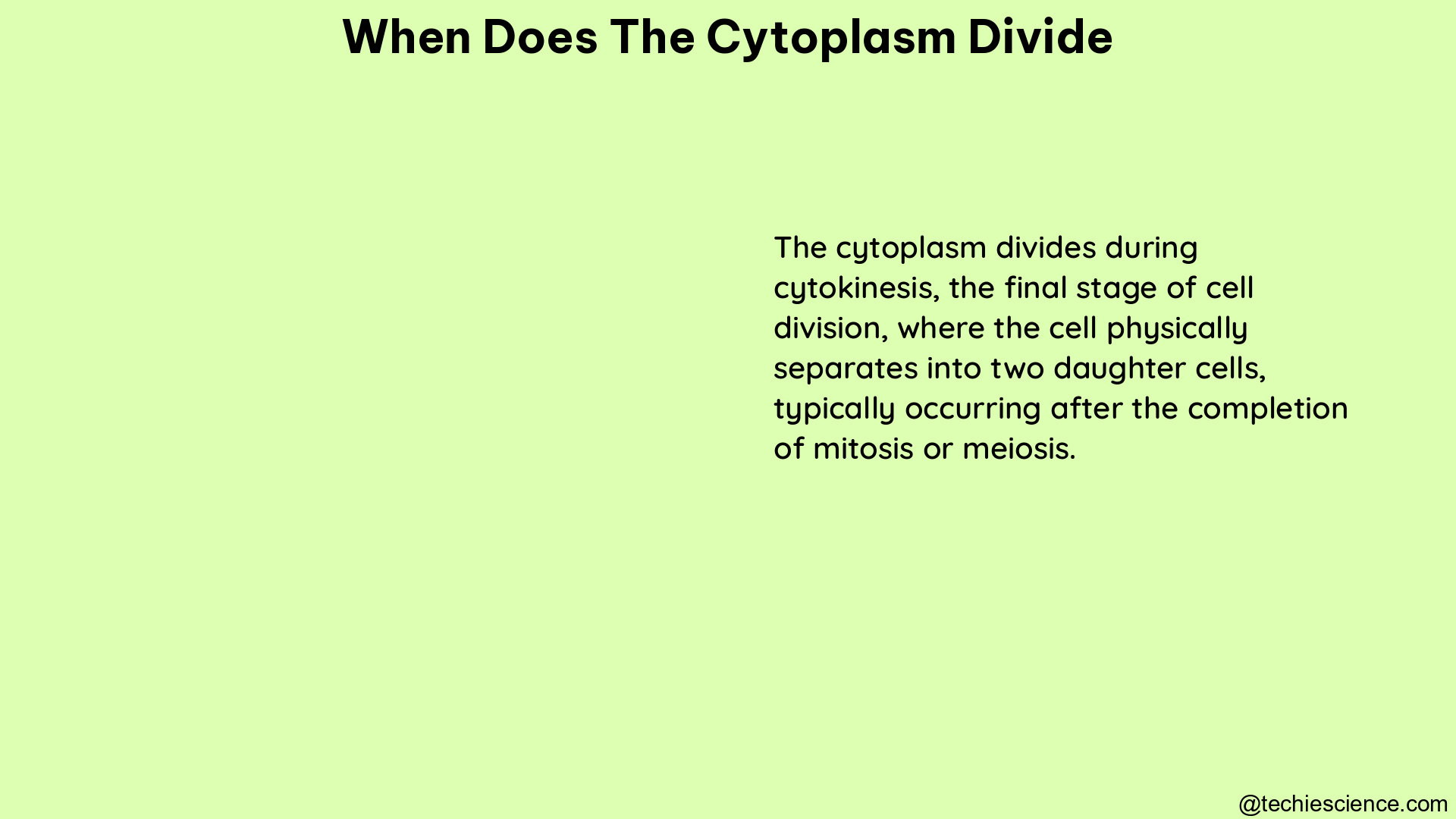The cytoplasm, the jelly-like substance that fills the interior of a cell, undergoes a crucial division process called cytokinesis, which occurs after the nuclear DNA has been replicated and segregated during the mitotic phase of the cell cycle. This intricate process ensures the equal distribution of cellular contents into two daughter cells, enabling the continuation of life and the propagation of genetic information.
Understanding Cytokinesis: The Cytoplasmic Division
Cytokinesis is the final stage of the cell division process, where the cytoplasm of a parent cell is physically divided into two distinct daughter cells. This event follows the successful completion of mitosis, the phase where the nuclear DNA is replicated and equally distributed to the two daughter cells.
Cytokinesis in Animal Cells
In animal cells, cytokinesis is initiated by the formation of a contractile ring, a band of cytoskeletal fibers composed primarily of actin and myosin. This contractile ring forms at the equatorial region of the cell and gradually constricts inward, creating a cleavage furrow that ultimately pinches the cell in two, resulting in the formation of two distinct daughter cells.
The process of cytokinesis in animal cells can be broken down into the following steps:
- Contractile Ring Formation: During the late stages of mitosis, the actin and myosin filaments in the cell’s cytoplasm reorganize to form a contractile ring at the equatorial region of the cell.
- Cleavage Furrow Formation: The contractile ring begins to constrict, creating a cleavage furrow that gradually deepens, dividing the cell into two halves.
- Cytoplasmic Division: As the cleavage furrow deepens, the cytoplasm is physically divided, and the cell membrane is pinched inward, resulting in the formation of two distinct daughter cells.
- Abscission: The final stage of cytokinesis involves the complete separation of the two daughter cells, a process known as abscission, which is facilitated by the breakdown of the remaining cytoplasmic bridge connecting the cells.
Cytokinesis in Plant Cells
In plant cells, the process of cytokinesis differs from that of animal cells due to the presence of a rigid cell wall. Instead of a contractile ring, plant cells undergo cytokinesis through the formation of a cell plate, a structure composed of plasma membrane and cell wall components delivered in vesicles.
The process of cytokinesis in plant cells can be described as follows:
- Phragmoplast Formation: During the late stages of mitosis, a structure called the phragmoplast, composed of microtubules and associated proteins, forms at the equatorial region of the cell.
- Vesicle Delivery: Golgi-derived vesicles containing cell wall and plasma membrane components are transported along the microtubules of the phragmoplast and fuse at the equatorial region, forming the cell plate.
- Cell Plate Expansion: The cell plate expands centrifugally, eventually reaching the cell walls and fusing with them, creating a new cell wall that partitions the parent cell into two daughter cells.
- Cell Wall Formation: The cell plate matures into a complete cell wall, separating the two daughter cells and providing structural support and protection.
Timing and Duration of Cytokinesis
The timing and duration of cytokinesis can vary depending on the cell type and the specific conditions of the cell cycle. In cultured mammalian cells, the duration of the cell cycle typically ranges from 12 to 24 hours, with the mitotic phase lasting approximately 1 hour and the cytokinesis phase taking an additional 20 to 30 minutes.
However, the duration of cytokinesis can be influenced by various factors, such as:
- Cell Size: Larger cells generally require a longer time for cytokinesis to complete, as the contractile ring or cell plate has a greater distance to travel to divide the cytoplasm.
- Cell Shape: The shape of the cell can also affect the duration of cytokinesis, as the contractile ring or cell plate may need to navigate around obstacles or irregular cell geometries.
- Protein Regulators: Certain proteins, such as the growth-arrest-specific protein 2 (GAS2), have been shown to inhibit cell division and influence the duration of cytokinesis.
By understanding the timing and duration of cytokinesis, researchers can gain insights into the regulation of cell division and the factors that influence this critical process.
Importance of Cytokinesis in Cell Division

Cytokinesis is an essential component of the cell division process, as it ensures the equal distribution of cellular contents, including organelles, cytoplasm, and genetic material, into two daughter cells. This equal partitioning is crucial for the maintenance of cellular homeostasis and the preservation of genetic information during cell proliferation.
Ensuring Genetic Integrity
During mitosis, the nuclear DNA is replicated and equally segregated into the two daughter cells. Cytokinesis then physically divides the cytoplasm, ensuring that each daughter cell receives a complete set of genetic material. This process is vital for maintaining the genetic integrity of the organism, as it prevents the formation of aneuploid cells, which can lead to various genetic disorders and diseases.
Enabling Cellular Differentiation
Cytokinesis also plays a crucial role in cellular differentiation, the process by which a cell becomes specialized to perform a specific function within an organism. By dividing the cytoplasm and its contents, cytokinesis allows for the asymmetric distribution of cellular components, which can lead to the formation of distinct cell types with different characteristics and functions.
Facilitating Tissue Regeneration
In multicellular organisms, the ability to undergo cell division and cytokinesis is essential for tissue regeneration and repair. When cells are damaged or lost, the remaining cells can undergo cell division and cytokinesis to replace the missing or damaged cells, restoring the integrity and function of the tissue.
Enabling Embryonic Development
Cytokinesis is a fundamental process in embryonic development, as it allows for the rapid division and proliferation of cells during the early stages of embryogenesis. This process is crucial for the formation of the various tissues and organs that make up the developing organism.
Regulation of Cytokinesis
The regulation of cytokinesis involves a complex interplay of various cellular mechanisms and signaling pathways. Understanding the regulatory mechanisms that govern cytokinesis is crucial for understanding cell division and its implications in various biological processes.
Cytoskeletal Dynamics
The dynamics of the cytoskeletal elements, such as actin and microtubules, play a crucial role in the regulation of cytokinesis. The assembly, disassembly, and reorganization of these cytoskeletal components are tightly regulated by a variety of proteins and signaling cascades, ensuring the proper formation and constriction of the contractile ring or the cell plate.
Cell Cycle Checkpoints
Cytokinesis is closely coordinated with the cell cycle, and its progression is regulated by various cell cycle checkpoints. These checkpoints ensure that the cell has successfully completed the previous stages of the cell cycle, such as DNA replication and chromosome segregation, before allowing cytokinesis to proceed.
Signaling Pathways
Several signaling pathways, including the Rho GTPase, Aurora kinase, and Polo-like kinase pathways, are involved in the regulation of cytokinesis. These signaling cascades coordinate the various cellular processes, such as contractile ring formation, cleavage furrow ingression, and abscission, to ensure the successful completion of cytokinesis.
Protein Regulators
Specific proteins, such as the growth-arrest-specific protein 2 (GAS2) mentioned earlier, can act as regulators of cytokinesis. These proteins can influence the duration, timing, and efficiency of the cytoplasmic division process, highlighting the complex and multifaceted nature of cytokinesis regulation.
Conclusion
In summary, the cytoplasm divides during the process of cytokinesis, which occurs after the successful completion of mitosis. This critical event ensures the equal distribution of cellular contents, including genetic material, into two daughter cells, enabling the continuation of life and the propagation of genetic information.
By understanding the mechanisms and regulation of cytokinesis, researchers can gain valuable insights into cell division, cellular differentiation, tissue regeneration, and embryonic development, ultimately contributing to our understanding of fundamental biological processes and their implications in various fields of study.
References
- Raven, P. H., G. B. Johnson, K. A. Mason, J. B. Losos, and S. R. Singer. “How Cells Divide.” In Biology. 10th ed. AP ed. (New York, NY: McGraw-Hill, 2011), 192.
- Mitosis/Meiosis, Science Flashcards – Quizlet. https://quizlet.com/254645589/mitosismeiosis-science-flash-cards/
- In what phase does the following event occur? The cytoplasm of the … https://homework.study.com/explanation/in-what-phase-does-the-following-event-occur-the-cytoplasm-of-the-cell-is-divided.html
- Zhang, Tong, Bama Dayanandan, Isabelle Rouiller, Elizabeth J. Lawrence, and Craig A. Mandato. “Growth-Arrest-Specific Protein 2 Inhibits Cell Division in Xenopus Embryos.” PLOS One. September 9, 2011. http://journals.plos.org/plosone/article?id=10.1371/journal.pone.0024698

Hello, I am Sugaprabha Prasath, a Postgraduate in the field of Microbiology. I am an active member of the Indian association of applied microbiology (IAAM). I have research experience in preclinical (Zebrafish), bacterial enzymology, and nanotechnology. I have published 2 research articles in an International journal and a few more are yet to be published, 2 sequences were submitted to NCBI-GENBANK. I am good at clearly explaining the concepts in biology at both basic and advanced levels. My area of specialization is biotechnology, microbiology, enzymology, molecular biology, and pharmacovigilance. Apart from academics, I love gardening and being with plants and animals.
My LinkedIn profile-